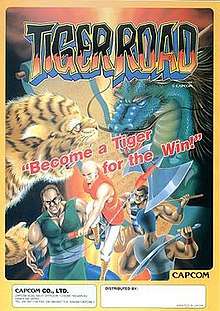Tiger Road
| Tiger Road | |
|---|---|
 | |
| Developer(s) |
|
| Publisher(s) | |
| Designer(s) | Tokuro Fujiwara |
| Composer(s) |
Harumi Fujita Tamayo Kawamoto Junko Tamiya |
| Platform(s) | |
| Release |
|
| Genre(s) | Action |
| Mode(s) | Single-player, Multiplayer |
Tiger Road (Japanese: 虎への道 Hepburn: Tora e no Michi) is a side-scrolling platform game originally released in 1987 as a coin-operated arcade game.
Home computer versions were released in Europe by U.S. Gold for the Amiga, Amstrad CPC, Atari ST, Commodore 64, DOS and ZX Spectrum. An alternate version for the Commodore 64 was released in the United States by Capcom who also published a Amiga 500 port of the game in that region.
A remade version for the PC Engine/TurboGrafx 16 was released in 1990 in Japan and North America.
The original arcade game is included in Capcom Classics Collection Vol. 2 for the PlayStation 2 and Xbox.
Plot
In Tiger Road, the player is placed in the shoes of a master of the Tiger Technique of Oh-Lin. Before the start of the game, the main character has been attacked by the warriors of the Dragon God, his sworn rivals. His soldiers have been killed, his secrets have been stolen, and the children studying Oh-Lin have been kidnapped. To win the game, the player must retrieve the stolen scrolls so that he can use the Double-Headed Tiger Fighting Technique to defeat the Dragon God, rescue the children, and reclaim his power.
Regional differences
The Japanese arcade release has additional sound hardware, allowing the game to play digital samples using an additional Z80 and MSM5205 digital sound chip. The World and USA releases had this removed, and these releases do not play any samples, lowering the production cost of the PCB.
Reception
The game was reviewed in 1990 in Dragon #156 by Hartley, Patricia, and Kirk Lesser in "The Role of Computers" column. The reviewers gave the game 4 out of 5 stars.[1]
References
- ↑ Lesser, Hartley; Lesser, Patricia; Lesser, Kirk (April 1990). "The Role of Computers". Dragon (156): 89–95.
External links
- Tiger Road at MobyGames
- Tiger Road at IGN
- Tiger Road Strategy Guide (TurboGrafx-16) at TurboPlay Magazine Archives